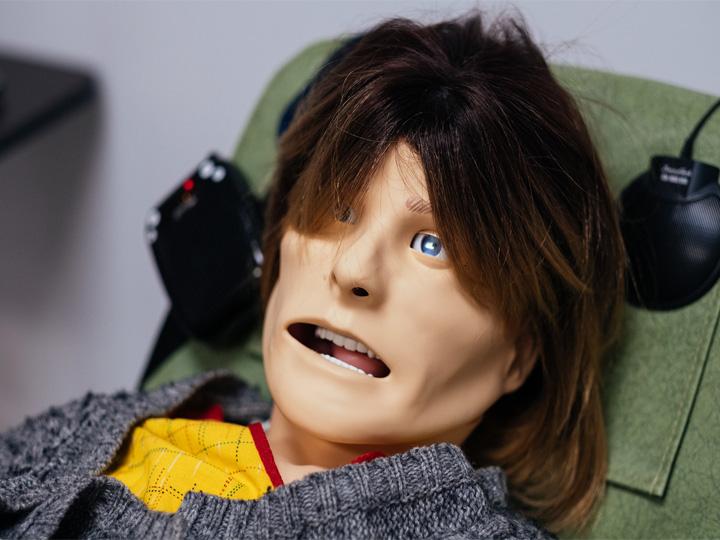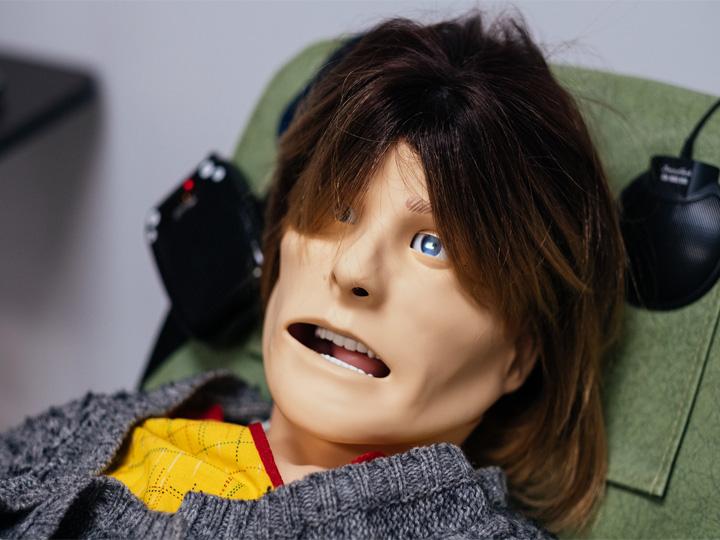
Credit: University of Houston
It's the conversation no one wants to have, but talking to patients and their families about death is inevitable for health care professionals. To address the limited clinical opportunities nursing students have to experience palliative care and end-of-life conversations, the University of Houston College of Nursing is now using a high-fidelity mannequin to simulate these challenging interactions.
"Nurses will tell you they don't feel confident or competent with this subject matter. That's an issue," said Cheryl Brohard, assistant professor and project director.
Funded by the Texas Higher Education Coordinating Board's Nursing Innovation Grant Program, this specialized training is believed to be a first-of-its-kind innovation used by collegiate nursing programs.
The female mannequin, nicknamed "Julia," is programmed to breathe, blink and even to simulate various medical conditions. In a nearby room equipped with a video and audio feed of the simulation lab, a faculty member plays the role of the patient, with students hearing the voice through a speaker near the mannequin. The dramatic interaction teaches students to respond appropriately when, for example, the patient turns blue due to lack of oxygen or becomes panicked while experiencing shortness of breath. The rest of the class watches via a projection screen in the classroom.
"This is great experience for real life, because when you walk through a patient's door, you never fully know what to expect," said nursing student Aashaqali Momin. "I'd rather be anxious here than be anxious out in the field. This is a valuable learning opportunity."
Brohard, who has completed End of Life Education Consortium training, spent 30 years as an oncology nurse and the last decade of her career working with hospice and other seriously ill patients.
"With this addition to our simulation lab, we're trying to make the students as comfortable as possible with a challenging but necessary situation," she said.
The simulation lab is designed to replicate a home-like setting, with the goal of building students' knowledge, communication skills and confidence with dying patients in a controlled environment. Students are told that "Julia" has terminal lung cancer. Her husband, played by a College of Nursing staff member, is by her side.
Students will be exposed to three end-of-life scenarios during their last two semesters of training. In the first, students sit face-to-face with the patient, who is coming to terms with her recent diagnosis. They'll discuss advanced care planning, including health care wishes and decision-making. Next, the patient's health will begin to deteriorate as the cancer progresses. Students will need to manage symptoms and dispense medication. Finally, the students will be with "Julia" and her husband when she dies.
"This is the area that physicians and health care providers really have a difficult time with. How do we start the end of life conversation? It's one of the most needed requests from our hospital partners," said Kathryn Tart, dean of the College of Nursing. "This research will not only educate our students, but it has far-reaching implications for the entire health care system."
The latest research shows that 713,000 people — or 28 percent of all deaths in the United States in 2015 — died in hospitals with nurses in attendance. Brohard says it's imperative that hospital-based nurses who provide direct care to these dying patients on a 24/7 basis are competent in palliative care and end-of-life care.
"You can read a book 10,000 times and you'll know what to do, but real life doesn't always work like the books. Unpredictable things happen," said nursing student Vy Pham. "The more times we can experience these scenarios, the more calm we feel."
###
This work was supported in whole or in part by a grant from the Texas Higher Education Coordinating Board (THECB). The opinions and conclusions expressed in this document are those of the author(s) and do not necessarily represent the opinions or policy of the THECB.
Media Contact
Chris Stipes
[email protected]
713-743-8186
@UH_News
http://www.uh.edu/news-events
Original Source
http://uh.edu/news-events/stories/2017/october/10122017Mannequin.php





